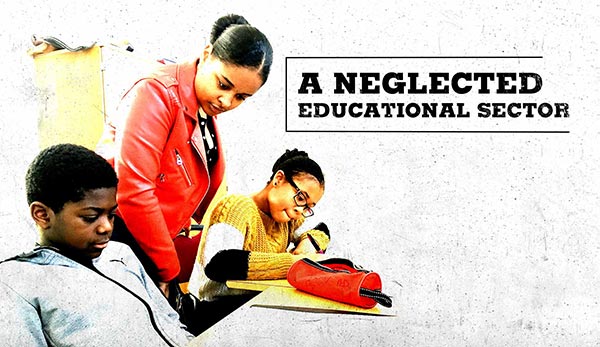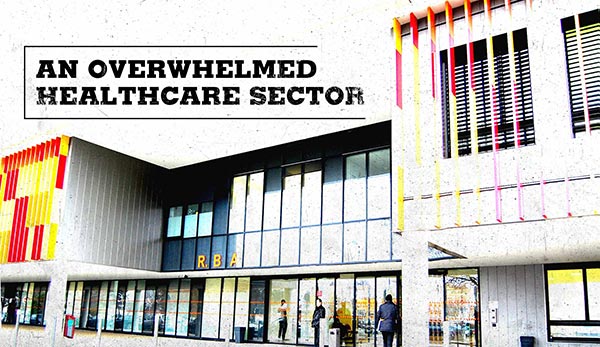In Dr. Marie-Josée Durieux’s unit, it takes 18 months to get an appointment with a children’s specialist. This paediatric psychiatrist at Robert Ballanger Hospital in Aulnay-sous-Bois is sounding the alarm. “What a waste of time,” she says, indignant. That sort of wait can have serious health repercussions on her very young patients suffering from early psychiatric issues, dyslexia, dyspraxia or signs of autism that include speech delays. “The disorders in the children we see are worsening, because they haven’t been looked after early enough,” Durieux says, annoyed. Child psychiatry as a sector is under strain, but the situation in Seine-Saint-Denis is worse than elsewhere. Here, there are only 4.23 child psychiatrists per 100,000 residents (compared to 15.92 in the greater Paris area as a whole), even though Seine-Saint-Denis is the youngest administrative department in France and home to a population that is particularly vulnerable.
“Most of the time, the problems [which generally begin when children are three years old] are detected at school. Parents call for an appointment and they discover they have to wait a year. Time goes by and the majority of children first come to us when they are older than four.” Dr. Durieux is livid. “The children who receive poor treatment today could grow up to be disabled adults who will have trouble finding their place in society. The France of tomorrow is being shaped today!”
‘All of our medical consultations are booked solid’
In her colleague’s unit, which treats diabetes, the situation is hardly better. “All of our medical consultations are booked four months, or even nine months, ahead,” says Dr. Laurence Vittaz, who heads the endocrinology unit. “The number of hospital stays with us has risen 46 percent in 10 years without a doctor or another nurse being hired. It is no longer possible to treat people in these conditions,” she says. Accentuating the problem of saturated hospital services in Seine-Saint-Denis is the dearth of general practitioners. “The follow-up care for the illnesses we treat were usually done by doctors in our sector who, increasingly, are retiring without being replaced.” Faced with that emergency, Dr. Vittaz wrote to France’s health minister last year. Her letter has yet to receive a reply.
The Regional Health Agency (ARS) in Seine-Saint-Denis recognises that the shortage of private practitioners here is a real problem. Since 2016, the state agency has designated half the department a priority zone, where financial assistance is on offer for young doctors to set up shop and practice in the area. “Seine-Saint-Denis is far from the poor member of the family in terms of receiving our funds, even though it is never sufficient given the demographic changes at play in the department,” concedes Jean-Philippe Horréard, the agency’s local representative.
Twice the risk of fatal heart attack in Seine-Saint-Denis
With neither family doctors nor specialists on duty in sufficient numbers, the health of residents in Seine-Saint-Denis is deteriorating faster than elsewhere in the country, according to Christophe Prudhomme, an emergency room doctor at the Avicenne Hospital in Bobigny and a CGT union representative. “Discovering cancers late is pretty frequent in our units. We pick up patients suffering from chronic pathologies that have not been monitored,” he says. “Others can’t get appointments within a reasonable time period and come to the emergency room because their condition has gotten worse in the meantime. Just last weekend, we saved an 85-year-old man with a pulmonary embolism at the last minute because he hadn’t found a doctor who could take him at the end of the week.”
Dr. Prudhomme’s overburdened colleagues at Seine-Saint-Denis’s emergency switchboard went on strike in December to demand extra personnel. “Before Christmas, it took us an average of 10 minutes to answer calls. Imagine if someone was calling us for a heart attack?” he asks. “In terms of the French medical system’s deterioration, we in Seine-Saint-Denis are 20 years ahead,” Prudhomme believes.
DThe department is lacking emergency vehicles, too. The resulting chaos is summed up in a study published in January by the Sudden Death Expertise Centre, which revealed that the risk of dying from a heart attack is twice as high in Seine-Saint-Denis as it is elsewhere in the country.
After the December strike, management at Avicenne Hospital promised 10 new hires. But that news wasn’t enough to reassure the emergency services doctor. “It’s something, but a restructuring plan underway is anticipating 60 to 80 job cuts this year, and the same goes for the four years to come,” he says.
In February, it was the emergency room personnel at Ballanger Hospital’s turn to cry foul. The situation there is nearly paralyzed. Ranked among the six most saturated emergency services in the country by the union Samu-Urgences de France, it was built to host 40,000 patients per year but ends up taking in approximately 75,000. The Regional Health Agency allocated €7 million for expansion works slated to last until 2021. “An initial response to the urgency of the situation that will only be effective if it is met with additional support,” wrote François Assensi, who presides over the hospital’s supervisory board, in a November letter to France’s health minister.
The Regional Health Agency, meanwhile, considers that the funds it provides have a “compensatory logic”. Ballanger Hospital, for example, benefits from “public interest funds that take the precarious living situations of its patients into account,” says its representative Jean-Philippe Horréard.
Prudhomme, for his part, accuses the State of not doing enough, whether in terms of funding for public hospitals or via regulations identifying and governing where doctors’ offices are needed. “It’s up to [the State] to put laws on this up for a vote, that’s its role. A whole population cannot be set aside, without the same rights in terms of medical treatment,” the doctor says.
Place santé, doctors on duty in a housing project
Despite its supermarket-like appearance, Place santé [Health plaza] is a community-run medical centre set in the heart of the Franc-Moisin low-income housing estate in Saint-Denis. On this January morning, a dozen people, including several with baby carriages, are waiting for the centre to open. Seven young doctors work here — a feat pulled off by Dr. Didier Ménard, Place santé’s founder. Having been an activist in this neighbourhood for 30 years, Ménard wanted to get the project on its feet before he even let himself think about retirement. What sets the centre apart is the presence of female health mediators, who help patients navigate through the administrative process.
Nathalie Coupeaux is one of these women. This morning, several young men who have exhausted their unemployment benefits have come in for Coupeaux’s help in requesting the State Medical Aid (AME) available to undocumented foreigners in France. “Send the dossier directly to Social Security in Bobigny. In Saint-Denis, they often lose documents,” she tells one of the men, Ladj, 20, who was injured in an accident but hasn’t had healthcare coverage for three months.
“What is the point of prescribing treatment if the patient can’t afford it? In order to solve medical problems, there are often social problems to solve,” says Dr. Ménard.
The centre is officially recognised as serving the public good and benefits from a sizable Regional Health Agency subsidy. The City Hall here in Saint-Denis, one of the cities that have decided to sue the State for “breach of equality”, also contributes, if more modestly, to the Place santé budget. Still, Emilie Henry, the facility’s director, worries about its future. “We have to fight every year for our budget. We already know that our departmental subsidy for 2019 will be slashed. The budget the State allocates to the department has been reduced and that impacts all service sectors.”
Another cause for concern: the scrapping of a “subsidised jobs” scheme means the mediator positions are at risk. “I don’t understand,” says Dr. Ménard. “We were identified as a project that should be supported and at the same time the State is displaying its lack of responsibility by weakening a facility like ours, in a place where the need is strong,” he says. One mother has been waiting in the hallway with her young daughter for more than three hours. The doctors and mediators go from appointment to appointment at a frenetic pace. In a single morning, some ten people were turned away, for lack of space.
Children in ‘The 93’ suffer most from the doctor shortage
In France’s youngest administrative department, the biggest victims of unequal access to treatment are children. This year, only a third of the positions for school doctors have been filled. Just as it is with child psychiatry, the national shortage is accentuated in Seine-Saint-Denis.
School doctor Pierrette Clozier, 74, is retired. But she still practices one day a week in Bagnolet. She alone covers a sector with 7,000 schoolchildren, from kindergarten through high school. Other cities in Seine-Saint-Denis, like Les Lilas or Romainville, aren’t so lucky. They don’t have doctors at school.
In these conditions, how can any school doctor juggle all the tasks he or she is supposed to accomplish? “The physical starting at age six is no longer performed, although it was useful. It allowed us to detect eye, hearing and speech disorders so as to prevent difficulties in learning to read,” says Clozier, a member of the SMedEN-FO union. There is no longer time to spend on drug prevention, STDs, contraception, nutrition or tuberculosis, either. And yet school doctors remain essential, bearing in mind that “the families’ situations are very unfavourable and some children never see a doctor,” says Clozier. More serious still, school doctors were sometimes the only people in a child’s life who could detect cases of abuse.
In Seine-Saint-Denis, the fact that school doctors are thin on the ground, in addition to the dearth of GPs, is all the more problematic because the poorest families do not necessarily travel for treatment. National Centre for Scientific Research health geographer Julie Vallée has shown that the poorer a population is, the more it develops an “impediment to distance”. “These people most often work strict jobs. They aren’t executives able to slip out for half a day to take their children to a doctor a little further away than anticipated,” she says. Hence the interest in providing health services close to where people live.


